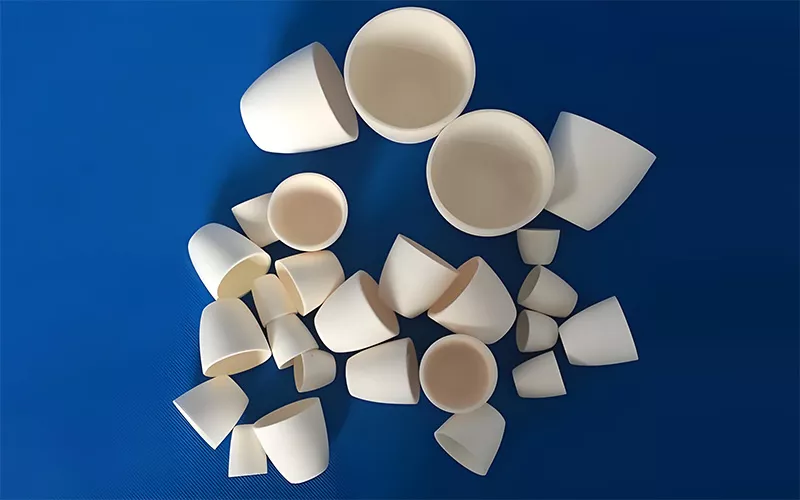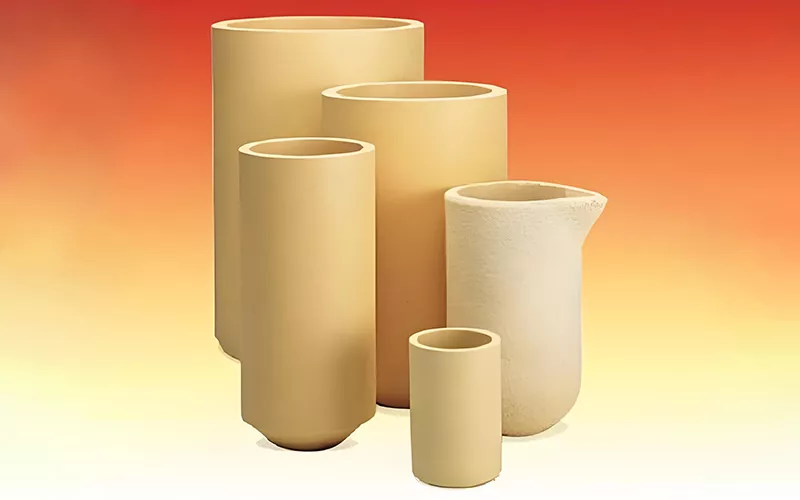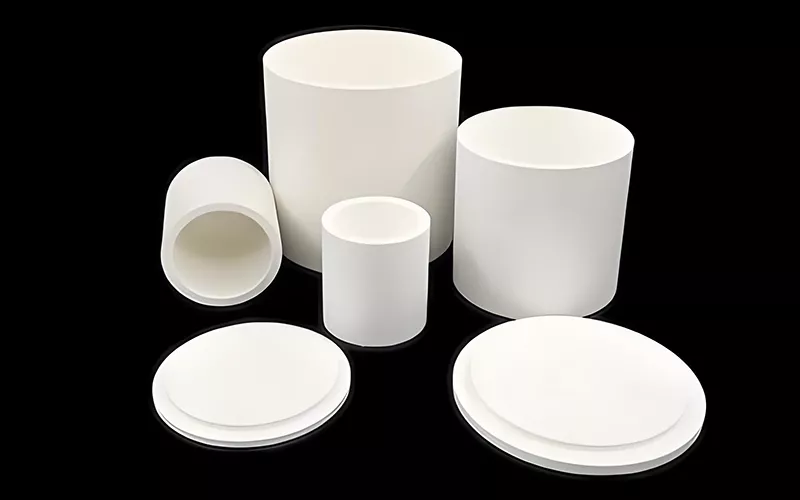Ceramic crucibles are containers with high melting points and high temperature resistance. They combine chemical stability with a low coefficient of thermal expansion, making them essential tools for extremely high-temperature applications in laboratories, metallurgy, semiconductor manufacturing, and other fields.
Ceramic crucibles are primarily made from advanced ceramics such as glinka, azotek boru, I tlenek cyrkonu. In this article, we’ll explore ceramic crucible material selection, key characteristics, and service life to help you select the most suitable crucible for your high-temperature application.

Z jakich materiałów wykonane są tygle ceramiczne?
Tygiel glinowy
Tygle ceramiczne z tlenku glinu are primarily made of 99.7% pure aluminum oxide. Did you know? During the production process, many manufacturers, such as GORGEOUS, add small amounts of magnesium oxide (MgO) and silicon dioxide (SiO2) to impart superior physical and chemical properties to the crucibles.
Key Features: High-Temperature Resistance - Alumina crucibles can withstand temperatures of approximately 1700°C in a redox atmosphere. While offering superior performance, alumina crucibles are also price-competitive, making them the preferred material for many manufacturers.
Applications: Alumina crucibles are primarily used in laboratory and industrial metallurgy, heating, and chemical reactions.
Advantages: Alumina crucibles are one of the most economical ceramic crucibles on the market. Alumina’s high melting point and low thermal expansion coefficient make them resistant to cracking. They are ideal reaction vessels for weakly alkaline substances.
Limitations: Strongly corrosive substances, such as the strong base sodium hydroxide (NaOH), can severely damage alumina crucibles. For these materials, GORGEOUS recommends using a crucible material with strong corrosion resistance instead of alumina crucible.
Tygiel cyrkonowy
Zirconia crucibles are primarily made of high-purity zirconium oxide. Their exceptionally high temperature resistance and chemical stability make them ideal for extremely high-temperature melting processes.
Key Features: Zirconia crucibles boast robust high-temperature resistance, capable of withstanding temperatures up to 2000°C, making them ideal for melting precious metals such as platinum (Pt) and palladium (Pd).
Zirconium oxide also possesses excellent chemical resistance, maintaining a stable structure even in harsh environments with strong acids and alkalis, making it an ideal crucible material for processes prone to corrosion.
Applications: Zirconia crucibles are primarily used in precious metal melting and certain processes involving high-melting-point materials.
Tygiel z tlenku glinu hartowany cyrkonem (tygiel ZTA)
Zirconia-toughened alumina crucibles (ZTA) are primarily made of 90% alumina and 10% zirconia. This ceramic material combines the advantages of both alumina and zirconia, offering excellent high-temperature resistance and high toughness.
Główne cechy:
High Toughness - The addition of zirconia significantly improves the crucible’s crack and wear resistance, reducing damage caused by high temperatures and mechanical shock.
High-Temperature Resistance - ZTA crucibles can withstand temperatures up to 1700°C and operate stably in high-temperature environments.
Thermal Shock Resistance - Compared to pure alumina crucibles, ZTA crucibles offer higher thermal shock resistance, are more stable under severe temperature fluctuations, and are less prone to cracking.
Applications: These crucibles are primarily used in processes requiring high mechanical strength and high-temperature stability.
Tygiel z azotku boru (tygiel PBN)
Boron nitride crucibles are specially designed for use at extremely high temperatures. Their primary component is pyrolytic boron nitride.
Główne cechy:
High-Temperature Resistance - Boron nitride crucibles offer exceptional high-temperature resistance. In a protective atmosphere, they can reach temperatures of up to 2100°C and remain stable. They will not melt or react chemically with the substrate at extremely high temperatures.
Thermal Conductivity - Boron nitride crucibles have excellent thermal conductivity, allowing them to quickly dissipate heat, effectively preventing localized overheating, thermal stress, and thermal damage.
Low Thermal Expansion Coefficient - Boron nitride has a low thermal expansion coefficient, effectively reducing the risk of crucible cracking in high-temperature processes requiring rapid cooling or heating.
Applications: Boron nitride crucibles are primarily used in high-temperature processes such as semiconductor manufacturing and metal smelting. In the semiconductor industry, they are often used in chemical vapor deposition (CVD), crystal growth, and high-temperature evaporation.
Inne materiały ceramiczne
Oprócz wymienionych powyżej powszechnie stosowanych materiałów ceramicznych, dostępne są również wysokiej jakości materiały na tygle, takie jak tlenek magnezu i tlenek berylu. Wszystkie charakteryzują się doskonałą odpornością na wysokie temperatury i są niezbędnymi materiałami na pojemniki tyglowe w wielu hutach i laboratoriach.
Jak zapewnić długą żywotność tygla?
If you want your crucible to have better performance and service life, you’d better do the following:
Składowanie:
Zużyte tygle najlepiej przechowywać w suchym i czystym miejscu, aby zapobiec wchłanianiu wilgoci i zanieczyszczeń. Należy unikać przechowywania tygli w pobliżu chemikaliów lub w pomieszczeniach o wysokiej wilgotności.
Działać:
Do obsługi tygla należy używać odpowiednich narzędzi, unikać bezpośredniego kontaktu z rękoma i po użyciu sprawdzać, czy nie ma pęknięć lub uszkodzeń.
Czyszczenie:
Należy dokładnie wyczyścić tygiel po każdym użyciu. Należy usunąć wszelkie pozostałości i pozostawić tygiel do całkowitego ostygnięcia przed czyszczeniem, aby zapobiec szokowi termicznemu i pęknięciom.
Często zadawane pytania
1. Czym jest tygiel?
Tygiel to pojemnik przeznaczony do stosowania w bardzo wysokich temperaturach, używany głównie do wytapiania metali i przeprowadzania reakcji chemicznych.
2. Jaka jest temperatura topnienia tygla ceramicznego?
Temperatura topnienia tygla ceramicznego zależy głównie od użytego materiału. Na przykład tygiel z tlenku glinu może wytrzymać temperatury od 1650°C do 1700°C, a tygiel z tlenku cyrkonu do 2000°C.
3. Jakie jest zastosowanie tygli ceramicznych w chemii?
Tygle ceramiczne są często stosowane w procesie wytopu metali w wysokiej temperaturze, jako pojemniki do przeprowadzania reakcji chemicznych, pojemniki do obróbki materiałów itp.
4. Jaką funkcję pełni tygiel ceramiczny?
Tygiel ceramiczny jest stosowany głównie do ogrzewania w wysokiej temperaturze, topienia lub rafinowania materiałów itp. Może również pełnić funkcję pojemnika w przypadku niektórych reakcji chemicznych.
5. Jakie są właściwości materiałowe tygli ceramicznych?
Materiały ceramiczne charakteryzują się wysoką temperaturą topnienia, niskim współczynnikiem rozszerzalności cieplnej, dobrą stabilnością termiczną i odpornością na korozję chemiczną.
6. Czy tygle ceramiczne można stosować do topienia silnie alkalicznych substancji?
Zależy to głównie od materiału, z którego wykonany jest tygiel. Zasadniczo nie zalecamy stosowania tygli z tlenku glinu do topienia silnie alkalicznych substancji, takich jak wodorotlenek sodu (NaOH) i nadtlenek sodu (Na₂O₂), ponieważ substancje te mogą powodować korozję tygla.
7. Jaka jest różnica pomiędzy tyglem porcelanowym a tyglem ceramicznym?
Tygiel porcelanowy zazwyczaj odnosi się do tygla wykonanego z porcelany. Tygiel ceramiczny ma większą wytrzymałość niż tradycyjny tygiel porcelanowy, wytrzymuje wyższe temperatury i ma lepsze właściwości mechaniczne.
8. Jak podgrzać tygiel ceramiczny?
Podczas podgrzewania tygla ceramicznego należy dobrać odpowiednią metodę ogrzewania, biorąc pod uwagę właściwości materiału, z którego wykonany jest tygiel. Należy pamiętać, aby unikać nagłego schłodzenia lub nagrzania podczas podgrzewania, ponieważ może to spowodować pęknięcie tygla.
9. Jakie są metody konserwacji tygli ceramicznych?
Po użyciu tygla należy go dokładnie wyczyścić, aby usunąć pozostałości, a następnie wyczyścić odpowiednim środkiem czyszczącym, a na koniec opłukać czystą wodą i wysuszyć w celu późniejszego użycia.
Wniosek
Ceramic crucibles are indispensable tools in modern chemistry and metallurgy. Capable of operating in extreme temperatures and harsh chemical environments, they play a key role in a wide range of scientific and industrial applications. GORGEOUS, a leading international supplier of advanced ceramics, offers custom-made ceramic crucibles in a variety of materials. Thank you for reading this article, and we hope you find it helpful.